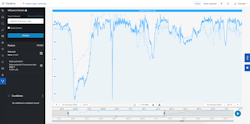Predictive monitoring: Achieving sustainability through self-service data analytics
The chemical compound we know as water is one of the most vital natural resources for human existence and needs to be monitored closely. Not only is clean drinking water essential for life itself, but acceptable water quality is necessary for a variety of industrial processes that create products to improve life.
Yet, H2O is scarce. Water treatment processes are energy intensive. Furthermore, regulations — global, national and regional — increasingly challenge companies to adhere to water use and discharge regulations, as well as energy consumption. Although fines vary by region, violating environmental limits can cost companies millions of dollars.
Digital transformation and the advent of Industry 4.0 have improved process data collection. The collected data, saved in a database known as a historian, can be useful in determining process variations or anomalies that could lead to water quality issues or an energy spike. Once a process expert can isolate and address the issues, a company can achieve its optimization and sustainability goals.
Water and wastewater: A closer look
Water is a part of nearly every industrial manufacturing process. The quality of water coming into a plant is critical. Processors have specific requirements that vary for utility water, such as cooling water, and for water used in the manufacturing process itself.
Eventually, companies must address used process water that is not fit for release into the sewerage system or the environment. The wastewater byproduct is an additional industrial water use challenge. Some companies invest in water recycling systems, while others treat the water before discharging it safely back into the environment.
The problem? Treating water requires extreme high-volume flows that require large, energy-intensive plants. These water treatment plants use pumps and extra treatment steps that can put a dent in a company’s sustainability program. Process experts also must use advanced separation techniques to ensure the quality of water is correct, which, in some cases, is down to the concentration of a few nanograms per liter.
Monitoring process data
Engineers are not data scientists. Raw process data requires the use of advanced analytics to reveal useful information. Historically, companies have turned to a data scientist to evaluate the process data. Unfortunately, data scientists are scarce. Furthermore, engineers and data scientists do not necessarily communicate in the same way. Data scientists likely would need significant support from engineers to understand the processes they are analyzing.
Self-service data analytics plays a key role in optimizing processes and improving sustainability. With a self-service solution, process engineers are empowered to analyze trends themselves without the help of a data scientist.
By looking at these trends over time, process experts can create a golden fingerprint that establishes ideal parameters from the collected process data. They then can set up monitoring systems and alerts to inform them when limits fall outside the ideal range.
Correlating water quality with live process data
To ensure water quality, monitoring concentrations of wanted or unwanted substances in the water is essential. Online concentration measurements often are complex and expensive. For some substances, it can be difficult or impossible. Therefore, many parameters of wastewater monitoring often are not available as live process data but are determined by sampling and lab analysis. Lab analyses can take hours or days. As a result, plant operators do not receive the analysis until it is too late to adjust the process operation.
Correlating lab analysis results with available live process data can help overcome this obstacle. The correlation can act as an indicator for adjusting the process operation in the future.
As an example, a chemical company in the Netherlands wanted to review the correlation between various process and wastewater parameters. Process engineers were especially interested in learning the influence factors on the concentration of organic acids.
To identify the correlation between the different parameters, the company established a self-service data analytics solution. Because organic acid concentrations were not part of the company’s historian, the first step of the solution was to import the lab reports into the self-service solution. This allowed the process engineers to evaluate the lab concentration measurements as time-series data.
The second step was to find influence factors for the organic acid concentrations. In this case, the redox value, available as live process data, was expected to have an influence on organic acid concentrations. The influence factor functionality of the self-service analytics solution allows linear regression to correlate multiple parameters at once. Process experts used this function to search for parameters that explain acid concentrations. The company also used the solution’s time-shift function to search for optimal correlation.
Process experts determined there was a clear correlation between the redox value and the n-butyric acid concentration five days later. They also found a correlation with other organic acids. With this knowledge, process engineers learned the redox value could be used to determine the acid concentration and intervene in the process in time if the water quality was not optimal.
The company saved time and money by ensuring it was complying with quality requirements.
Monitoring and reporting effluent quality
A Canadian mining company has strict government regulations regarding the quality of water that the mines discharge into the environment. The average flowrate and pH value of effluents (liquid waste discharged into a river or the sea) must be reported monthly to the Canadian government.
The plant processing wastewater shuts down frequently. When a shutdown occurs, the pH reports show sharp peaks and drops. This leads to inexact average calculations in the overall pH of the discharged wastewater.
The plant had been using a spreadsheet to evaluate the minimum and maximum values each day and manually removing them if the values appeared to be incorrect. It made the decision to move to advanced self-service analytics so it could smooth out the pH level.
Process experts created new tags and filters in the self-service solution so they could see the relevant data without irrelevant values interfering. They then extracted the average, minimum and maximum values of the pH over time. Engineers then created context items to find events where the pH level was excessive.
With the help of self-service data analytics, the mining company was able to save a view of the corrected flowrates and pH values. Once a month, process experts can open the saved view. The comparison table immediately shows all relevant and correct pH levels during the month. In turn, the company can send the report to the Canadian government and remain in compliance.
The mining company not only saved a lot of time, but also achieved greater sustainability by complying with regulatory requirements quickly.
The journey to digital transformation
Companies go through a series of technical advancements over time. Each step demonstrates a growing digital, and even analytical, maturity. Plants move from a state of capturing data to analyzing it for continuous improvements.
While some industries have adapted quickly to Industry 4.0, the water and wastewater industries have been slower to adapt. Analyzing water and wastewater process data not only contributes to sustainability and energy efficiency, but it also optimizes processes and improves the quality of production.
Once a company has enabled a self-service data analytics solution, process engineers can manage by exception. The solutions allow process engineers to view time-series data, create an ideal profile and monitor for events outside the scope of the profile.
In this way, self-service data analytics saves time, cuts costs, reduces environmental fines and contributes to overall sustainability — both inside and outside the plant.
Charlotte Fischer is a customer success manager at TrendMiner where she helps companies and software users become successful with their self-service analytics programs.
About the Author
Charlotte Fischer
Customer Success Manager, TrendMiner
Charlotte Fischer is a Customer Success Manager at TrendMiner where she helps companies and software users become successful with their self-service analytics programs. She previously was a project engineer at Blücher GmbH, where she specialized in water treatment with activated carbon. Charlotte earned a master's degree in Biochemical Engineering at TU Dortmund and an MBA with a focus on Process, Quality, and Digital Change Management at FOM Cologne.


